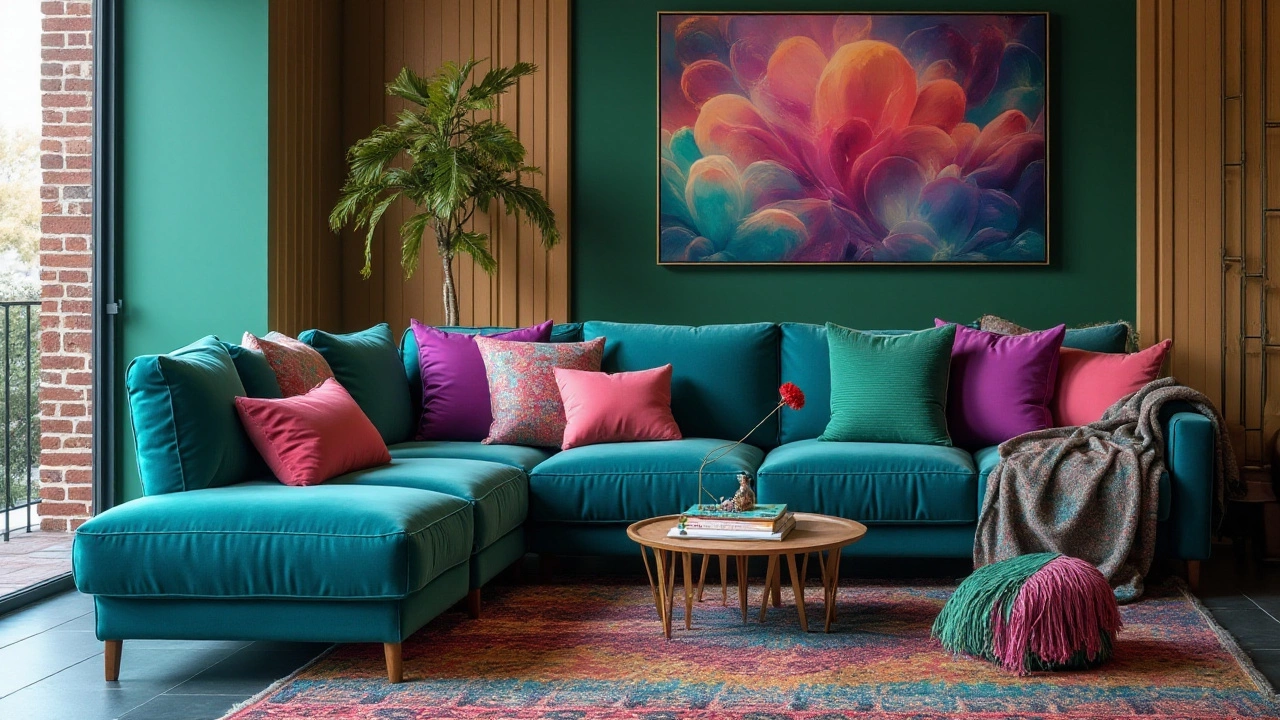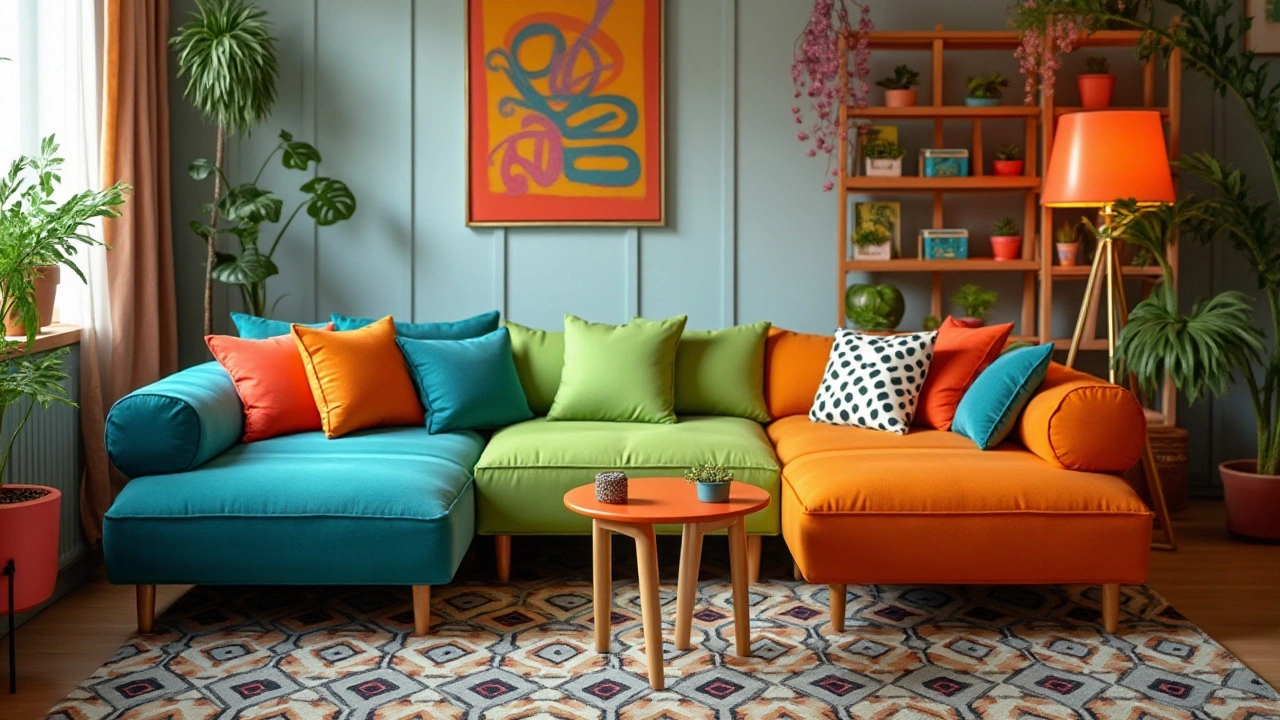As we step into an era shaped by Gen Z, understanding their affinity for certain colors helps us gauge more than just aesthetic preferences—it reveals a cultural narrative that intertwines individualism and social consciousness. In the realm of interior design, especially when it comes to furniture such as corner sofas, these color choices are more than mere trends; they are statements of identity.
Gen Z approaches color with a fearless disposition, steering away from the ordinary and embracing shades that speak volumes. Their favorite colors are not dictated by tradition but are chosen for their ability to convey mood, environment, and personality.
In this article, we will explore how these preferences find their way into the cozy corners of our homes, manifesting through chic and versatile corner sofas that reflect an evolving lifestyle.
- The Colorful Language of Gen Z
- The Rise of Bold and Unconventional Hues
- Understanding the Emotional Impact of Color
- Corner Sofas as Canvas for Self-Expression
- Tips for Incorporating Gen Z Colors at Home
The Colorful Language of Gen Z
Gen Z is redefining how color influences our environments, and their choices are anything but predictable. This generation, born into a digitally-saturated world, finds its inspirations not just in traditional color palettes but in the kaleidoscopic offerings of graphic design platforms, social media aesthetics, and gaming universes. Their preference for color is vibrant and transformative, breaking away from the muted tones that dominated previous generations' homes.
Colors such as electric blue, neon green, and millennial pink have emerged as significant players in Gen Z's design preferences. Social media giants like Instagram and Pinterest have become breeding grounds for these color trends, where each post and pin is a testament to the mood and energy these hues encapsulate. As young architects of their own spaces, Gen Z seeks to blend these colors into furniture pieces like corner sofas, turning them into bold statements that express individuality and break away from the norm. A study by WGSN, a leading authority in trend forecasting, revealed that over 70% of Gen Z respondents stated that color plays a crucial role in creating moods and defining spaces in their homes.
"For Gen Z, color is not just a choice, it's a lifestyle. It's their way of communicating emotion and identifying their uniqueness in an overly saturated digital landscape." - Cassandra Napoli, Trend Specialist at WGSN
This generation utilizes colors to reflect their values— Sustainability, creativity, and inclusivity. The rise of biophilic design has also encouraged earth tones and botanical shades, connecting with a collective urge to bring the outdoor world into our living areas. These choices signify a deeper, more conscious connection with the environment, which is profound considering Gen Z's advocacy for climate change and sustainability issues.
Gen Z's role in reshaping color norms extends beyond just boldness. They are experimenting with color psychology, acknowledging how different hues influence emotions. This study into the emotional impact of color is why soft pastels might find a spot next to richer tones, creating a balance that speaks of serenity and vitality. It's common for a corner sofa to feature an array of scatter cushions, each one in a color deliberately chosen to evoke certain emotions and atmospheres within their living space.
The Rise of Bold and Unconventional Hues
In recent years, as we pay closer attention to the changing tastes of younger generations, it's impossible not to notice how Gen Z has revolutionized color use in home decor. Their inclination towards colors that are bold and unexpected marks a decisive shift from the restrained palettes of previous generations. Neon greens, electric blues, and bright oranges have started to adorn the living spaces, particularly in pieces like corner sofas. These choices are not just about making a statement; they're enveloped in the psyche of a generation that thrives on self-expression and vibrancy.
Many factors contribute to this colorful divergence. One significant aspect is social media's influence, providing a platform for creativity and display. Platforms like Instagram and Pinterest overflow with rooms passionately curated, filled with pieces that scream individuality. Even subtle pieces, such as a corner sofa draped in a daring chrome yellow or a whimsical lavender, allow individuals to declare their personal brands. This break from conventional hues in favor of dynamic ones expresses more than personality; it challenges traditional norms and represents an embracing of diversity.
Experts in color theory also suggest that such choices are tied to emotional well-being. Bold colors are often associated with increased energy and positive moods, which can invigorate a living space. According to Leatrice Eiseman, executive director at the Pantone Color Institute, "Color is a power which directly influences the soul."
"For Gen Z, color has become an extension of their digital life, translating the vividness of online interactions into their homes," she asserts. This quote illustrates how color is no longer a mere adornment; it is seen as an essential component of the digital-era lifestyle.
Interestingly, the sustainability movement also plays a role in these color selections. Gen Z is notably conscious of the environment, favoring brands and materials that align with these values. As a result, many unconventional colors come through sustainable processes or repurposed materials. The rise of eco-friendly dyes and recycled textiles allows for a rich variety of audacious shades that attract conscious consumers. A corner sofa in stunning terracotta might not only stand out decoratively but may also speak to the occupant's values.
Incorporating these hues into a living space can be exhilarating yet daunting. For those looking to dip their toes into this trend, consider starting with small elements—cushions, throws, or an accent chair in a bold shade can add pops of color without overwhelming. If a daring corner sofa becomes the focal piece, complement it with neutral walls and understated decor to balance the room. By thoughtfully integrating these colors, one can achieve a harmonious blend of standing out while still remaining inviting and cozy.

Understanding the Emotional Impact of Color
The science of color psychology offers fascinating insights into how hues influence our emotions and behaviors. Within the sphere of home decor, colors play a silent yet powerful role in shaping the mood of any space, particularly when it comes to hefty pieces like corner sofas. These are not just seating arrangements; they become the focal point around which the atmosphere of a room revolves. Gen Z, with their intuitive grasp of visual language, use colors as tools to craft spaces that enhance well-being and self-expression. Their choices reflect a deeper understanding of how different colors can communicate distinct feelings.
Vibrant colors like electric blue and fiery red can energize a room, making it feel more dynamic and lively. On the other hand, softer shades like lavender or mint green are often chosen for their calming effects, ideal for creating a serene and welcoming oasis in bustling homes. Gen Z, known for their attention to mental health, tend to favor these calming colors in their personal spaces, believing that a peaceful environment contributes to a balanced mind. This selection often extends beyond mere preference and taps into a strategic approach to improving daily life through interior choices.
"Color is a power which directly influences the soul." - Wassily Kandinsky
According to color theorists, each hue carries specific connotations and elicits predictable reactions. Yellow, with its sunny disposition, is perfect for individuals looking to add some optimism and cheer. Conversely, monochromatic schemes involving dark greys and blacks may appeal to those Gen Zers who appreciate a minimalist and modern aesthetic. These shades, when used thoughtfully, can turn a living room into a sophisticated and understated environment. The rising preference for such palettes marks a shift towards simplicity that doesn't compromise on elegance.
To illustrate Gen Z’s adventurous color choices, consider a study by the Interior Design Society, which found that 68% of young adults preferred to experiment with at least three different color textures and patterns in their living spaces. This statistic sheds light on their knack for mix-and-match artfulness, which celebrates diversity and creativity. With this in mind, it becomes clear why Gen Z's influence over color trends in home decor has become so pervasive. When selecting colors for corner sofas, this generation isn't just paying homage to aesthetics but deliberately crafting an environment that resonates with their personal narrative and emotional needs.
Corner Sofas as Canvas for Self-Expression
The corner sofa has become more than just a piece of living room furniture; it is a blank canvas waiting to be personalized and transformed into a style statement. For Gen Z, a generation renowned for its embrace of bold individuality, these sofas serve as a medium to express personality and creativity. The beauty of corner sofas lies in their versatility. They provide ample space to incorporate everything from electric blues to soft pastels, enabling an exciting palette that speaks to the playful and dynamic spirit emblematic of Gen Z.
Traditionally, sofas were chosen based on practicality and neutral aesthetics to fit a broad range of décor styles. However, Gen Z defies this convention by choosing corner sofas in vibrant and non-traditional colors, like teal, mustard yellow, or even a deep forest green. These choices are often inspired by their broader design principles rooted in self-expression and mood elevation. It's not uncommon to find a Gen Z home displaying a bold sofa against a minimalist room, allowing the color to pop as a focal point of the living space.
This tendency towards color uniqueness aligns with their broader preference for sustainability. By selecting striking colors that stand out, Gen Z consumers avoid the repetitive cycle of replacing furniture frequently to keep up with trends. Instead, they opt for pieces that offer longevity and relevance across different design moods and seasons. According to a recent survey by a leading interior design magazine, about 65% of Gen Z respondents prefer bright or distinctively colored sofas over traditional neutral ones. This shift is fundamentally changing how furniture brands approach the manufacturing and marketing of corner sofas to resonate with their target demographic.
The Psychology of Color
When Gen Z chooses colors for their corner sofas, they tap into a wealth of cultural and emotional associations. Colors like peach or coral might remind them of calm sunsets and evoke tranquility, while deep reds and purples could create a sense of opulence and mystery in their living space. The choices are not arbitrary; they are reflections of an individual's world view and emotional state.
A renowned psychology professor once noted, "Color is a powerful communication tool that can modify mood and behavior." This sentiment is even more potent in a home setting, where color choice directly affects the ambiance. This generation's deep understanding of color psychology compels them to experiment with shades, making corner sofas the ideal furniture for artistic exploration. An understated gray hue can signal sophistication, while a lively green can infuse energy and creativity into the room—a crucial consideration for those who also use their living space as a workspace.
For someone eager to bring these vibrant palettes into their home, don’t shy away from combining vibrant hues with more muted shades to create depth and interest. Consider pairing a richly colored sofa with contrasting cushions, throws, or rugs to balance out the room's aesthetics. Here are a few ways Gen Z integrates their favorite hues into their corners
- Use color blocking with cushions.
- Incorporate matching or contrasting curtains for a cohesive look.
- Add indoor plants whose green leaves complement the bold colors.
- Choose art pieces with similar color tones.

Tips for Incorporating Gen Z Colors at Home
Diving headfirst into the world of Gen Z colors can bring a refreshing breath of vibrant air into your living spaces. These bold hues often reflect energy, uniqueness, and vibrancy, making them perfect for personal expression through interior design. When starting with corner sofas, which are central in a living room setup, going with striking colors can set the tone for the entire décor. To effectively incorporate these colors, start by considering the existing elements within your home—walls, floor, and other furniture. This way, you'll ensure harmony while allowing the boldness of Gen Z colors to stand out prominently.
One practical approach is to start small. For instance, you might seek accent items that already embody these bold hues, such as cushions or throws, before committing to a larger piece like a sofa. Layering colors and textures can also be very effective. Gen Z's favorite colors often revolve around bolder shades like electric blue, emerald green, and vibrant coral. These can either be used as block colors for an entire sofa or more subtly as accents. Interior design experts often suggest painting a focal wall in the same shade to not only match but amplify the impact of these colors in a room. Gradually incorporating these hues can provide you the freedom to experiment and adapt to what feels best within your personal environment.
Another important aspect is understanding the mood and emotional resonance each color can bring. Colors like blues typically evoke calm and focus, while warmer tones such as orange and yellow ignite energy and creativity. Choosing corner sofas in hues that enhance your emotional well-being could contribute to a more inviting and harmonious home atmosphere. You may even mix colors from the same palette to create a sophisticated, yet playful, look. A recent study on color psychology suggests that environments with varied yet harmonized colors often promote increased happiness and relaxation.
"Colors aren’t static; they’re dynamic characters woven into our lives,” says Emma Lloyd, a well-regarded design psychologist, “They affect our emotions and interactions subtly but profoundly."
Recycling decorative items and playing with textures can offer different shades of the same color, bringing depth and interest without overwhelming the senses. Gen Z appreciates sustainability, so sourcing eco-friendly and sustainable materials in their choice of colors becomes an aspect of their ethical living. Look into buying from local artisans or reupholstering old furniture with new fabrics in trending colors to blend old with new consciously.
Finally, be open to experimenting and rearranging your setup until it reflects your personal individuality and style. Even though Gen Z color trends might seem bold to some, treating such interior updates as an evolving process can help foster creativity and personal satisfaction. Take closing inspiration from seasonal décor which can offer a regular update of colors depending on weather changes, subtly affecting inside themes without a complete overhaul.

